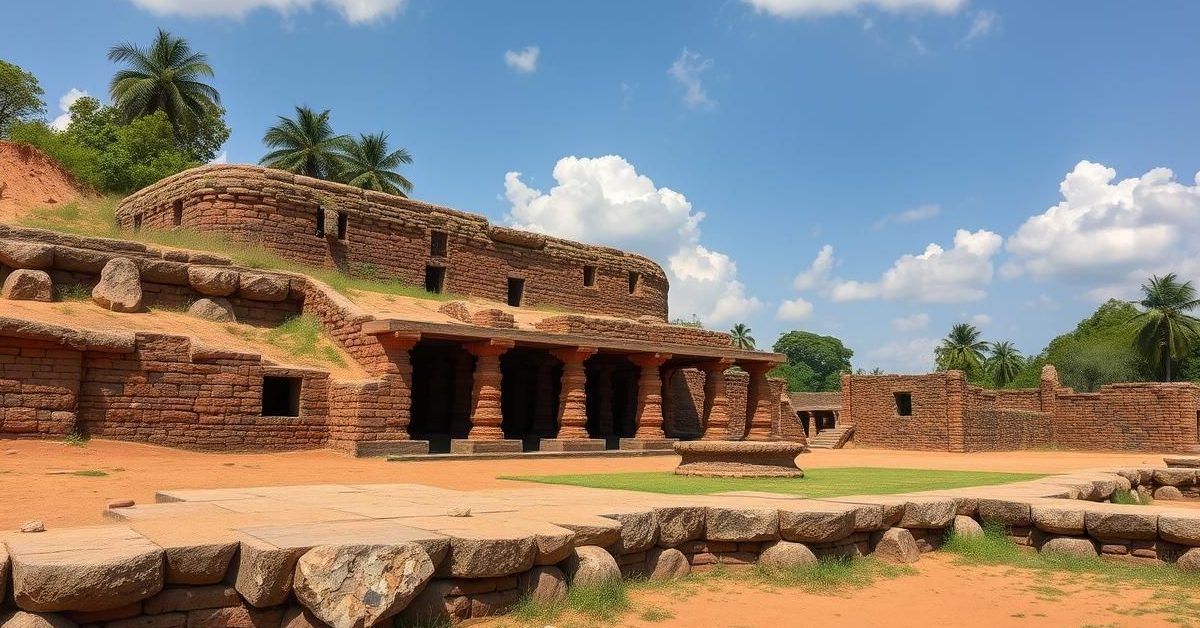The archaeological site of Keeladi in Tamil Nadu is transforming our understanding of ancient Indian history, revealing a sophisticated urban civilization that challenges previously held beliefs about the subcontinent’s development.
Keeladi: Unearthing an Ancient Urban Hub
Once a quiet village along the Vaigai River in Tamil Nadu, Keeladi has emerged as a profoundly significant archaeological site. Excavations, initiated in 2014 by archaeologist K. Amarnath Ramakrishna under the ASI, have uncovered remnants of an advanced urban settlement.
The findings include impressive brick structures, industrial furnaces, intricate drainage systems, and pottery marked with graffiti. These discoveries suggest a highly developed society with sophisticated planning and craftsmanship.
The Dating Debate
Ramakrishna’s final report, submitted in January 2023, proposed a dating for the site between the 8th and 3rd centuries BCE, based on scientific analysis. However, the Archaeological Survey of India (ASI) later asked for a revision, suggesting an earlier period of “at the maximum, somewhere in pre-300 BCE.”
Ramakrishna defended his scientific chronology, asserting that the evidence supports an earlier timeline. This debate highlights the importance of the findings, as an older date for Keeladi could significantly alter our understanding of South Indian history.
Echoes of the Sangam Era
The discoveries at Keeladi are not just historical; they resonate deeply with the Sangam era, a period of rich Tamil literature and culture. Evidence of trade, such as carnelian beads, and literacy, seen in Tamil-Brahmi inscriptions on potsherds, paints a picture of a flourishing civilization.
Experts like Adrija Roychowdhury of The Indian Express note how closely artifacts from Keeladi align with descriptions in Sangam texts. For example, iron smelting tools found at the site corroborate ancient poems detailing iron production. Similarly, a unique burial urn found aligns with Sangam verses about double burials.
The site’s connection to the Sangam era is crucial, making it relatable to the living cultural traditions of South India. Names found on potsherds, like ‘Aadhan,’ also appear in Sangam texts, reinforcing this link. While Keeladi has garnered significant attention, other sites like Porunthal and Kodumanal had previously offered clues about early urban development and writing in Tamil Nadu.
Recent Discoveries at Keeladi
Excavations continue to yield fascinating insights. Recently, archaeologists unearthed a crystal quartz weighing unit from the Sangam era. This finding is particularly exciting because ancient weighing units were typically made of stone, making this crystal discovery unique.
Other recent finds include a terracotta hopscotch, an iron nail, and various types of pottery like black and red ware, and red slipped ware. An earthen snake figurine was also discovered, adding to the diverse array of artifacts.
Beyond Keeladi: Other Important Sites
Rakhigarhi: A Harappan Giant
In Haryana’s Hisar district, Rakhigarhi stands as one of India’s largest Harappan civilization sites, alongside Dholavira in Gujarat. It has been declared a protected monument under the Ancient Monuments and Archaeological Sites and Remains Act, 1958.
Excavations at Rakhigarhi have revealed well-structured houses, intricate lane and drainage systems, and what appears to be a jewelry-making unit. Finds include copper and gold jewelry pieces, terracotta toys, and thousands of earthen pots and seals.
A significant find is a cylindrical seal featuring five Harappan characters and an alligator symbol. DNA studies from skeletal remains suggest an independent origin for the Harappan people, challenging theories of ancestral links to steppe pastoralists or Iranian farmers.
Ratnagiri: Odisha’s Buddhist Gem
In Odisha’s Jajpur district, the Buddhist complex at Ratnagiri has yielded remarkable discoveries. Recent excavations uncovered a colossal Buddha head, a massive palm, an ancient wall, and inscribed Buddhist relics, all estimated to date back to the 8th and 9th centuries AD.
Ratnagiri is part of Odisha’s famous “Diamond Triangle,” along with Udaygiri and Lalitgiri. This trio of Buddhist heritage sites is believed to have been an important center for the Vajrayana (Tantrayana) school of Buddhism, which emphasized acquiring mystical power.
The Ratnagiri monastery is unique in India for its curvilinear roof and is believed to have housed around 500 monks at its peak. These ongoing excavations continue to shed light on India’s rich and diverse ancient past.
- Keeladi in Tamil Nadu reveals an advanced urban settlement possibly dating as far back as the 8th to 5th century BCE.
- A debate exists with the ASI regarding the precise dating of Keeladi, with the lead archaeologist defending an earlier timeline.
- The site’s findings, including Tamil-Brahmi inscriptions and artifacts, strongly link it to the ancient Sangam era, challenging narratives of uniform urban development in India.
- Recent unique discoveries at Keeladi include a crystal quartz weighing unit, a rare find compared to traditional stone units.















